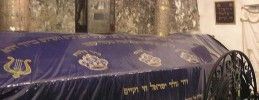King Davids Tomb
March 22nd 2011
Where is King David buried? Archaeologists may never find the answer to that question, but that has not stopped thousands of pilgrims, worshipers and tourists from visiting the sarcophagus on Mount Zion traditionally thought to hold the famous king’s remains.
The tomb is located in a thousand-year old building and is always surrounded by Jews praying, reciting Psalms and studying Torah. Shavuot eve, the anniversary of King David’s death, is an especially busy time at the tomb, with prayer and study continuing all night long. The second floor of the building houses a Christian holy site, thought to be the location of the Last Supper, and the upper floor houses a Muslim minaret. The building is one of the few sites in the word shared by the three monotheistic religions.
King David was the Israelites’ greatest warrior king, extending the kingdom to its largest size. He was also one of the most righteous kings, with Jewish tradition assigning him the role of a great Torah scholar as well. He was the first to suggest building a Temple in Jerusalem and purchased the plot for it himself. However, it was his son Solomon who was given permission to build a house for the Lord.
 The location of King David’s tomb has never been known, but biblical tradition stated that he was buried in the City of David, which contemporary archeologists believe was located outside of the area known today as the Old City of Jerusalem.
The location of King David’s tomb has never been known, but biblical tradition stated that he was buried in the City of David, which contemporary archeologists believe was located outside of the area known today as the Old City of Jerusalem.
In the 12th century, Benjamin of Tudela reported the miraculous discovery of the tomb during refurbishment of a church on Mount Zion. Mount Zion came under Israeli control after the War of Independence in 1948, and it was the closest site to the Western Wall and Temple Mount that Jews could visit until the Six Day War in 1967.
The tomb is open 8:00 am until sunset (closes on Fridays at 2:00 pm April through September and 1:00 pm October through March). Men and women are separated. Men should cover their heads (kippot are provided).












